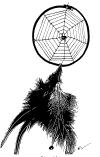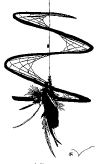Traditional Ojibwe EntertainmentLong before television
and video games, people found ways to amuse themselves. The Ojibwe made up
games and used songs and dances as early forms of entertainment.
Childís Play
A game that is still played today by children in the
United States was being played by Ojibwe children long before non-Indians
came to this country. That game is hide-and-seek. It was known as "the
butterfly" game to Ojibwe children in those days. In the Ojibwe version of
the game, one child would cover his eyes while the others hid. When everyone
was ready, he would begin to search for them while singing "Mee-mem-gwe,
mee-mem-gwe (butterfly) show me where to go."
Music and Dances
The Ojibwe used songs for dances, games, to proclaim love,
and to entertain children. Drums and wooden flutes were used for
accompaniment.
One of the social dances the Ojibwe enjoyed was the
begging dance in which dancers went from wigwam to wigwam, or house to
house, begging for food for a feast. Another popular dance was the womanís
dance, in which many gifts were exchanged.
Games
Ojibwe adults played two classes of games: games of chance
and games of skill. The moccasin game was a game of chance. The rules of
this game are very complex, but the basic idea is that one player hides a
marked marble under one of four moccasins, and the other player has to guess
where the marble is. The moccasin game has been played for generations by
Ojibwe People, and continues to be played today.
One game of skill that was commonly played is the lacrosse
game, which was similar to modern lacrosse. In this game, a deerskin-covered
wooden ball is tossed with a racket made from a sapling. Opposing teams
tried to catch the ball with the racket and carry it to the other teamís
goal.
For the Ojibwe, an important aspect of all games is fair
play. Being honest in everything you do is an important part of the Ojibwe
belief system, and it is reflected in their popular forms of entertainment.
Traditional Ojibwe Gambling
Like many other cultural groups that play games involving
gambling, the Ojibwe people have their own traditional gambling games.
However, just as bingo (which might be played at churches for recreation or
to raise money for a parish) is not a part of Christianity, gambling is not
a part of the Ojibwe religion. Casinos are owned by Ojibwe tribes, but they
are not directly linked to Ojibwe religious ceremonies.
While traditional Ojibwe games are not religious, their
rules do take into consideration the Ojibwe belief system. Because Ojibwe
People believe that all things are interconnected, it would be impossible
for an Ojibwe to totally separate a recreational activity from his or her
beliefs.
The Ojibweís traditional moccasin game provides a good
example of how Ojibwe beliefs are incorporated into a recreational activity.
An important aspect of the moccasin game is that there is no way to cheat in
it. Playing fairly ó being honest in everything you do ó is a part of the
Ojibwe belief system; therefore, it is reflected in this popular game. The
game also allows players to learn about human nature ó to observe behavior,
to interpret body movements, and to learn the importance of patience.
The rules of the moccasin game are very complex, but the
basic idea is that one player hides a marked marble under one of four
moccasins and the other player has to guess under which one it was hidden.
The moccasin game was played for generations by Ojibwe people, and continues
to be played today.
Throughout the periods in history when Christian
missionaries spread their gospel to Indian reservations, white people
strongly disapproved of any cultural activities, including the moccasin game
and other Ojibwe gambling games. Over time, the Ojibwe adopted other games,
such as bingo, into their recreational activities. Eventually, this meant
card games, too. So, as you can see, gambling does have its place in Ojibwe
history.
Ojibwe Stories
Iíve heard that storytelling is a very important part
of the Ojibwe culture. What are some traditional Ojibwe stories?
Because storytelling so important, we would like to review
some of that material, and print the story of Papase (The Woodpecker) in
this monthís Cultural Column.
According to Ojibwe legend, storytelling season begins
with the first snow and ends with the first clap of thunder. Long ago,
people owned stories or legends and only they could tell them. In order for
another person to tell a particular story, he or she would have to get
permission from its owner and offer the owner tobacco, a blanket, clothing,
food or something else. Today, it is still customary to offer an Elder
tobacco (or something else they like) for them to tell a story.
Through storytelling, Mille Lacs Band Elders help younger
people learn about the world around them. When they grow up, these children
continue the storytelling tradition with their own children and
grandchildren. One often-told story, called Papase (The Woodpecker), teaches
a lesson about greediness.
Papase
A woman wearing a red scarf, a black dress, and a white
apron was cooking in her kitchen early one morning when an old man
approached her. "May I have some bread, please?" he asked. "Sure," she said.
The woman had just prepared a big batch of dough to make
fry bread (a traditional Ojibwe bread), so she put a nice big piece of dough
in the fry pan. It turned out to be a really nice piece and she thought, "I
canít give him this one ó itís much too nice." For the second piece, she put
a smaller amount of dough in the pan. Well, this piece turned out much
better than the first and she thought, "Oh, this one is also too nice to
give to this old man." So, she started on a third piece. This time, she put
barely any dough in the pan. When it was ready, she was very surprised, for
this piece had turned out even more beautiful than the all the others.
Finally, the old man asked, "Is there any bread ready
yet?" So she threw some crumbs in the pan and they produced by far the most
beautiful piece of fry bread. This made her angry. "Quit begging," she
cried. "Get out of here! You canít have any of my bread!" The old man
stopped begging all right. He stomped his foot a few times and said, "From
now on youíre going to have to hunt and search for your food." And he turned
the woman into a woodpecker.
Printed with permission from the storyteller.
White Eagle Soaring: Dream Dancer of the 7th Fire







 Get
a course to promote your business online, explode your sales
Get
a course to promote your business online, explode your sales Get
software to promote your business online in less time
Get
software to promote your business online in less time Get
software to streamline your business and run it hands free.
Get
software to streamline your business and run it hands free.